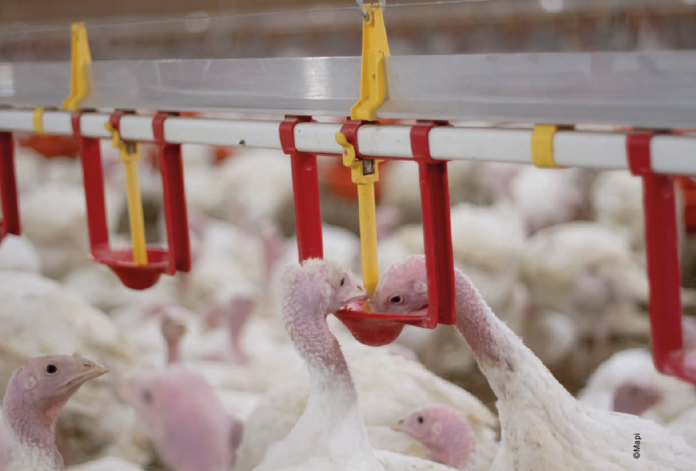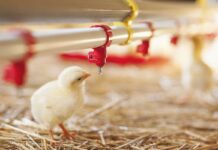
When we talk about optimizing immunization through proper vaccination in commercial turkeys, we are really talking about optimizing drinking water vaccination when we think about what takes place on the farm. Most of the time, when water vaccination audits are performed, companies are amazed at the opportunities that are identified. Seems pretty simple, add vaccine to the drinking water, and consider them vaccinated. This talk will focus on how to avoid having to wait on an audit to identify opportunities for improving the immunization process. We will also briefly touch on how to maximize your coccidiosis vaccination through field management.
Kelli H. Jones, DVM, MAM, diplomate ACPV
Manager of Technical Services, Ceva Animal Health
Drinking Water
Vaccination in commercial turkeys is almost exclusively done via the drinking water, so obviously there needs to be a strong focus on this aspect of the program. Not only should drinking water be fresh and clean, it should be free of disinfectants and impurities at the time any vaccine is added. Vaccines administered in the drinking water are live organisms, so preserving their viability is critical. Vaccine stabilizers are a good idea if simply used as insurance against anything in the water that could denature the vaccine organisms. Water sanitation should be discontinued at least 12 hours prior to vaccination.
Water line biofilm in drinker lines should also be considered. Biofilm typically harbors pathogenic bacterial and viral organisms, and has a window to proliferate when water sanitation is discontinued for the vaccination process to take place. I am very partial to the continuous water line sanitation programs such as chlorine dioxide systems that do wonders to eradicate biofilm when flocks are in the barn. With something like this, you are at a lower risk of the biofilm wreaking havoc in turkey flocks because biofilm levels are minimal when the system has to be turned off for vaccination.
Cold chain
Now that we have discussed the importance of having clean water for use during the water vaccination process, let’s discuss what critical control points must be observed along the way. Let’s start with the vaccines themselves. This starts at the supply cooler back at the office or warehouse. Proper cold chain should be observed, and you should follow manufacturer’s recommendations for storage. Some sort of temperature monitoring during storage should become routine. If at any time during the handling and storage process cold chain is disrupted, viability of live vaccines is at tremendous risk. In addition, appropriate inventory and storage of vaccines should be performed. Older serials should be moved forward when new serials arrive so that the oldest products are used first. Having said this, ensure vaccines are used within the expiration dates. Serial numbers and expiration dates should be recorded for every bottle removed from the cooler prior to heading out to the farm. That way, if there are concerns down the road, then there are records to examine if needed.
In addition to preserving cold chain during storage, it is just as important to ensure vaccines are transported and handled properly in route to the farm. For instance, I don’t know how many live fowl cholera bottles I have swabbed over the years, and have not been able to recover any Pasteurella from the bottles during a vaccination audit. It is important to remove only the amount of vaccines needed for that particular vaccination. Record the number of bottles you remove. Take only what is needed! Vaccines should be immediately placed in a transport cooler with frozen ice packs. Depending on manufacturer’s recommendations, most typically suggest a transport temperature of 35-45F. If you can have the cooler pre-cooled, then that is even better. Temperature guns or probes work well as field monitoring tools to ensure coolers don’t become too warm.
Farm prep
Prepping the farm for the vaccination is perhaps one of the most critical steps of the entire process. We already discussed discontinuing water sanitation at least 12 hours prior to vaccination, but it also makes sense that the birds should be thirsty before you offer them vaccinated water. Turkeys drink most of their water in the first few hours of daylight, so drinking water should be turned off early enough for the birds to drink most of the water out of the lines well prior to vaccination. Water vaccination should take place first thing in the morning.
It is very helpful to raise, drain and prime water lines with vaccine water prior to lowering lines for birds to access. Five gallon buckets at the end of the lines work well, and you would be surprised at how much water actually drains even after “water restriction” is implemented.
Prior to even thinking about mixing up vaccines, the water reservoir and pump system used to mix and administer the vaccines should be cleaned and flushed well. It is important to ensure cleaners are thoroughly rinsed out, as they could have a negative effect on live vaccines.
Generally a good thorough flush just with clean water after vaccination, and again prior to the next vaccination should keep it acceptably clean.
Vaccine mixing
Fill water reservoir with enough clean water to last 1-3 hours (25-40% of the birds’ daily intake) and stabilizer. Mix the vaccines per labeled directions with (preferably distilled) water and stabilizer in a separate bucket, and ensure vaccine is released and dissolves quickly. Opening vials under the water takes advantage of a pressure change that causes a rush of water into the vials that helps to release and dissolve the vaccine. It is a good practice to rinse the empty bottles in the water to make sure all vaccine is flushed from the bottles. Add the vaccine water bucket to the larger reservoir, and mix well. Some sort of submergible pump stirring apparatus works well. Add dye, and make sure everything is stirred well.
Turn on the pump and flush the drinker lines while still raised until the dye appears at the end of the lines. Only now are the birds ready to be vaccinated.
Vaccinating birds
Once the drinkers are lowered, the birds should be very ready for a good drink of fresh vaccine water. The goal should be for every bird to get a drink, so if birds are observed not on the drinker then try to stir them by walking the flock. The vaccine reservoir should be emptied within 2-4 hours after the lines are lowered. This is about the time where most of the live vaccines start to lose a lot of their viability outside of the cold chain. You should be able to return water sanitation around one to three hours after the reservoir completely empties. Do not forget to do this step, as biofilm will quickly take advantage of any opportunity to develop.
Checking vaccination
Tongue checks work very well for determining uptake of the vaccine in a barn. One hundred or so birds is a good rule of thumb to check. Checks should be randomly conducted throughout the barn, and should be done pretty soon after vaccination, as the dye only causes a brief temporary staining of the tongues. Blue dye may also be visible through the skin around the crops of vaccinated birds. Every bird without dye should be considered a missed bird. Monitoring will help identify potential opportunities for improving your process if needed.
Coccidiosis vaccine field management
Over 80% of a coccidiosis vaccination actually occurs in the field, so it would be a disservice not to at least touch on this. It is important to allow birds to re-cycle vaccine cocci oocysts for a minimum of three good cycles. If birds cycle weekly, then that makes the first three weeks of life a focus. Only fecally shed vaccine oocysts that undergo sporulation will become infective to activate another life cycle. Oocysts need certain parameters to sporulate, namely moisture, heat and oxygen. Targeting litter moisture of 25-35% will help with this, as will density control to ensure birds shed oocysts in their feces throughout the barns appropriately. Management details will be discussed further in the presentation. Stay tuned!

















